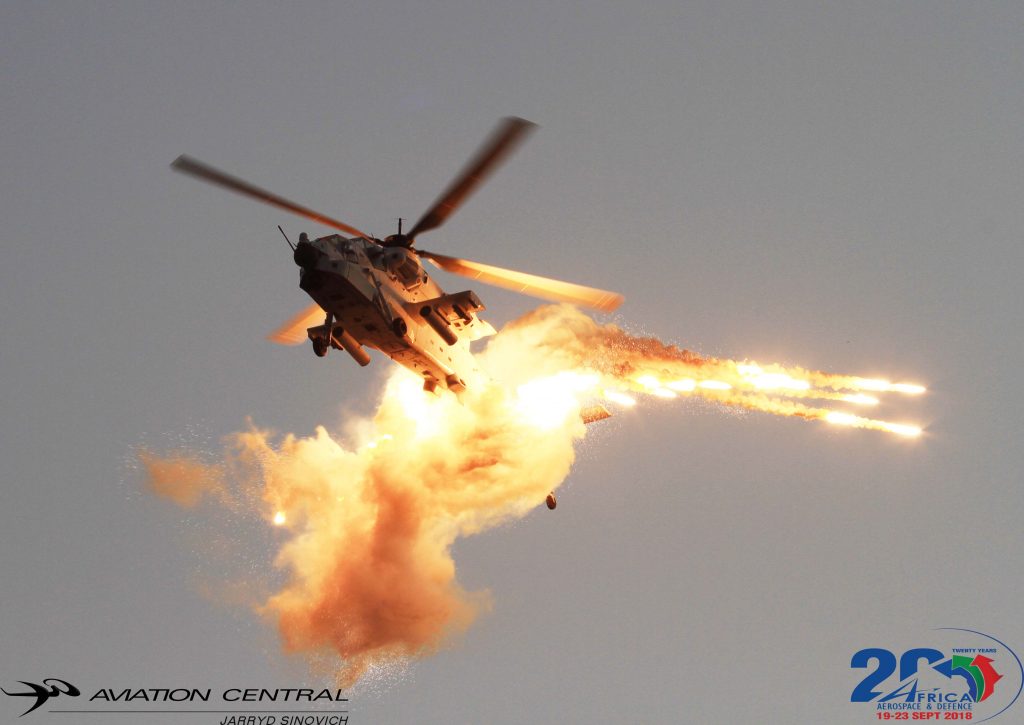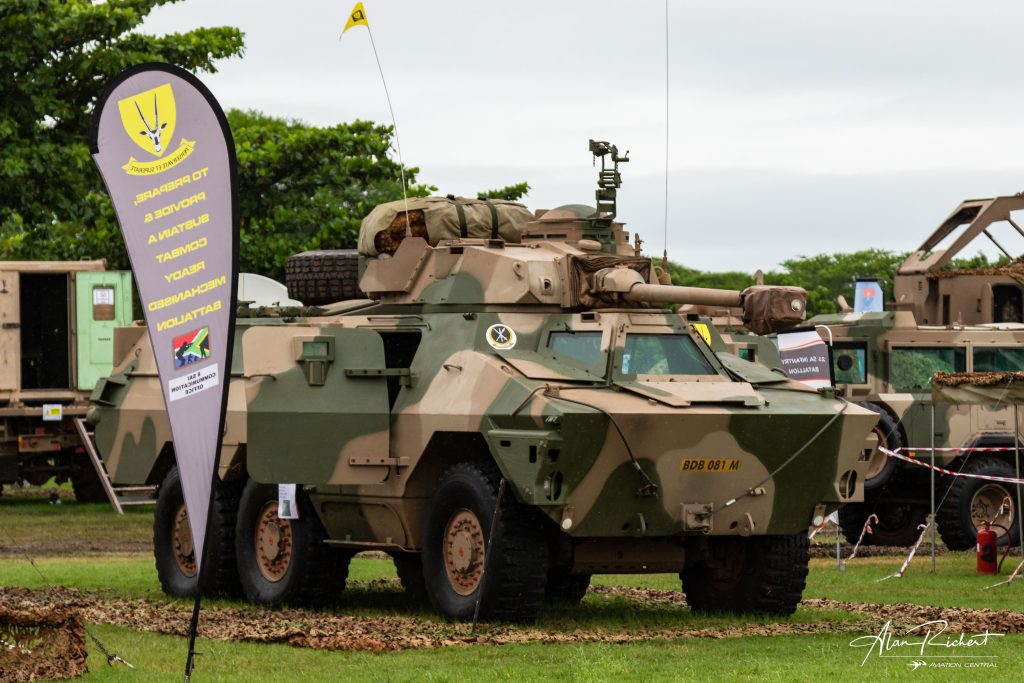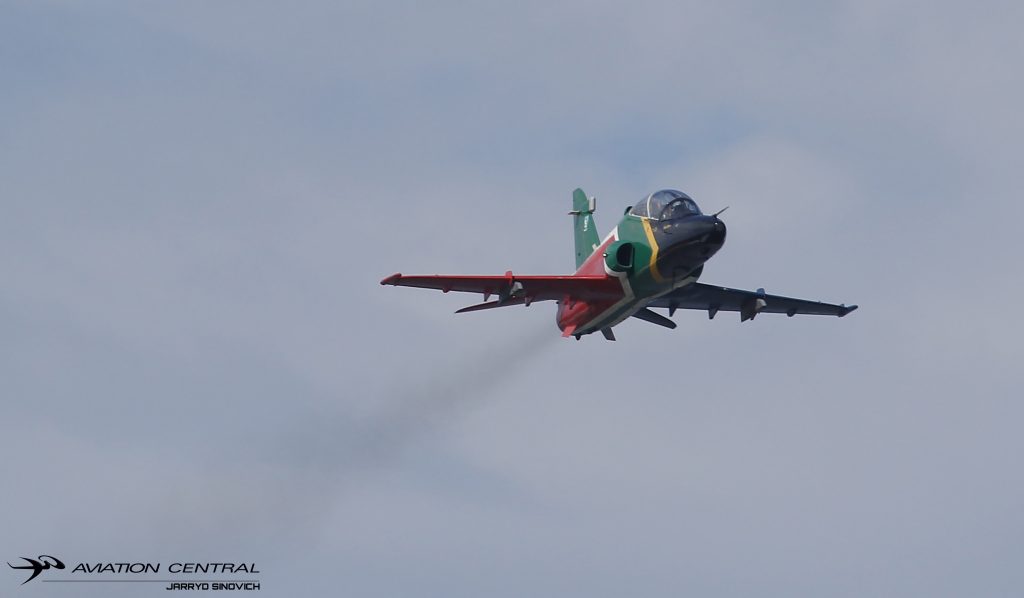Tag Archives: RooivalkAttackHelicopter
SANDF at the Rand Easter Show 2022
After a two year absence it was the return of the Rand Easter show at Johannesburg Expo Centre, Nasrec.

One of the big attractions of course would be the South African National Defence Force which has been taking part in the demonstrations or static exhibit since 2011.

This year unfortunately there was no capability demonstration as previously reported on. We found our self’s in the static exhibits and just thanking that we can attend these outdoor shows once again.

We found ourselfs at 16 Squadrons exhibit with a Rooivalk Attack helicopter and found our good friend and former Silver Falcons Aerobatic Team leader Lt Col Omphile “Biggy” Matloane. Biggy as he is known is now part of the big guns at 16 Squadron flying the Denel Rooivalk.


Was good to see a 15 Squadron Agusta A109 also in the static park. We hope next year we will see the return of a capability demo as it was a crowd favorite. Until next year!

First Rooivalk Flight 11th February 1990-30 Years On!
The Denel Rooivalk is an attack helicopter manufactured by Denel Aviation of South Africa. Rooivalk is Afrikaans for “Red Falcon”

The Rooivalk attack helicopter First Flight Rooivalk XDM was 30 years ago on the 11th February 1990,back in the days of the then Atlas Aircraft Coporation now known today as Denel Aeronautics.

Development of the type began in 1984 by Atlas Aircraft Coporation its development is closely connected to the Denel Oryx medium transport helicopter, both aircraft being based on the Aerospatiale SA330 Puma Helicopter and having started development at the same time on both projects.

Development of the Rooivalk was protracted due to the impact of limited budgets during the 1990s, and a desire to produce a highly advanced attack helicopter.

Developing an entirely new helicopter from scratch would have involved designing and developing many accompanying subsystems and components, such as the turboshaft engines and the dynamic systems, such as the main and tail rotor systems and the gearboxes.

Due to the great difficulty posed by the prospects of designing and manufacturing a clean-design helicopter, which would have substantially increased the cost and timescale of the project, it was decided to base the attack helicopter upon an existing design. At the time, the SAAF operated two principal helicopter types – the Alouette III and the SA330 Puma.

The Alouette III was a small helicopter which originated from the 1960s; due to the age of the design and a lack of engine power, it was not considered a favourable candidate for further development work.

The Puma was substantially larger and was equipped with more powerful engines; both factors provided a broader basis for the accommodation of additional equipment and for potential growth.

Another key factor for its selection was the parallel development of a localised and improvement model of the Puma in South Africa, known as the Atlas AS32 Oryx. The Oryx possessed an increased power-to-weight ratio and had improved performance in the high temperature climate that the type was typically being operated in; development of the Oryx was far quicker than what would become the Rooivalk as it was a more straightforward program.
Other potential sources were mooted, such as the use of propulsion elements of the Aerospatiale Daulphin ; the adoption of these components has been speculated to have likely resulted in a smaller and potentially more economic rotorcraft.
Ultimately, it was decided to adopt both the powerplant and dynamic systems of the Oryx—which bore significant similarities to their Puma and now Airbus Helicopters AS332 Super Puma ancestors—as the basis for the planned attack helicopter;
Commonality with the Oryx systems would simplify logistics and reduce maintenance costs. This meant that the attack helicopter would have a significantly large airframe, giving it long range and the capability to carry many sensors and armaments.
During the 1980s, the defence budgets of South Africa were relatively generous, especially in contrast to later decades, thus Denel sought to provide a rotorcraft that would be amongst, even potentially superior to, the best attack helicopters in the world.

The helicopter, later named the Rooivalk, was envisioned as an agile, highly sophisticated gunship, especially suited to the threats of the Angolan conflict and countering vehicles such as the T-55 battle tank.

Three Rooivalk attack helicopters have been deployed with the United Nations to support of the stabilization in the Democratic Republic of Congo in 2013.

There has been more occasions where the Rooivalks have seen action with the support of fire power in the DRC on a number of peace support missions since 2013.

The Rooivalk attack helicopter is based at Airforce Base Bloemspruit in the Central Free state province, flying for 16 Squadron, also home to 87 Helicopter Flying School, flying Agusta A109LUH and Oryx helicopters. The South African Airforce have just under a dozen on strength flying to date.
General Fabian “Zakes” Msimang stated:”The continued operation and future sustainability of the hardest working air assets of the SAAF being the Oryx, Rooivalk and C130, rely on an efficient and effective Original Equipment Manufacturer and Technical Design Authority of the Rotary Wing assets” during the recent Prestige day parade held at AFB Swartkop on January 31.




















































































































































































































































































































































